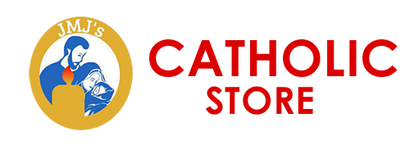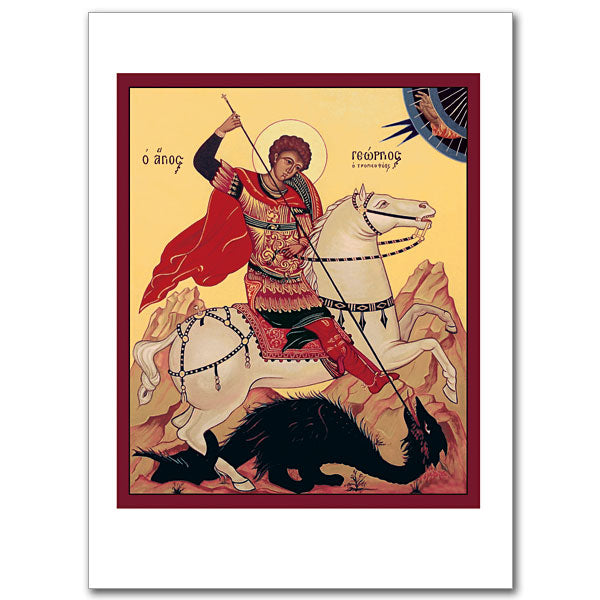Inside Text:
Blank inside.Bible Verse:
Ephesians 6:11Put on the whole armor of God, so that you may be able to stand against the wiles of the devil.
Item Details:
Much of what we know of St. George (d. circa 303 A.D.) is wrapped in legend. St. George is a very popular saint in Eastern Orthodox Churches. But George is also very highly respected among the English, who made him their country’s patron. This icon written by Sr. Mary Charles, OSB, is based on the historical icons that started to emerge in the 14th century. The depiction recounts a legend—more symbolic than historical—that St. George rescued the daughter of the king of Libya from being offered as a human sacrifice to appease a dragon terrorizing the city. Upon seeing the courage of the saint and the power of God at work in him, the citizens were converted to the faith and underwent baptism. St. George’s name day is celebrated April 23rd. Card size 4 3/8" x 6".
Icon greeting cards are single-fold cards printed on heavy stock, 4.38" x 5.93". The cards are blank inside for your own message or custom imprint and have an explanation of the history and symbolism of the icon printed on the back.
Image Origins
Much of what we know of St. George (d. circa 303 A.D.) is wrapped in legend. He was probably born to Christian parents and inherited lands in Palestine, where he became a Roman soldier. He was known to be a staunch Christian, and when given orders by the emperor to persecute others of the faith, he refused to obey. George was tortured, and later decapitated. His name day is celebrated April 23rd. St. George is a very popular saint in Eastern Orthodox Churches. But George is also very highly respected among the English, who made him their country’s patron. The English flag’s “Union Jack” cross is from St. George’s coat of arms. Early icons of St. George were portraits (strict iconography does not show how martyrs died, but as they are now, glorified in heaven). As his popularity spread and the stories of his life were embellished, he was depicted in more elaborate scenes riding a white horse, and even slaying a dragon. Starting in 14th century the so-called Vita (“Life”) icons of the saint became popular. This genre shows the portrait of the saint in the main panel, with smaller squares around the border depicting scenes from the saint’s life. This icon written by Sr. Mary Charles, OSB, is based on the historical icons that started to emerge in the 14th century. The depiction recounts a legend—more symbolic than historical—that St. George rescued the daughter of the king of Libya from being offered as a human sacrifice to appease a dragon terrorizing the city. Upon seeing the courage of the saint and the power of God at work in him, the citizens were converted to the faith and underwent baptism. It is possible that the slaying of the dragon may be a Christian version of the Perseus legend.
Theology and Symbolism
This image is striking for its powerful, fluid movement and at the same time its deep serenity. George’s red cape flaps behind him, which gives a sense of movement, but also calls to mind the working of the Holy Spirit that “blows where it will” (Jn 3:8). Following the lance upward, it appears as if St. George is effortlessly driving the weapon into the dragon. The mountains and even the dragon itself are rather small, making the saint appear even more monolithic. St. George wears red, symbolizing his martyrdom. Red also denotes passion, appropriate for a saint who was a zealous defender of the faith. While other icons from this period often depict figures with very little perspective, warriors are deliberately painted as strong and vibrant characters to indicate that their strength was blessed by God. The white horse is probably a symbol of purity, but the color also calls to mind baptismal imagery. The contrast between the white horse and the black dragon is striking; black is the traditional color used for Satan in iconography. The beast is symbolic of paganism and evil passions. The beast seems smaller than one would expect, but this is probably to show that evil is no match for good. In the right corner of the icon is the hand of God descending to bless St. George in his endeavor. It is also an indication that St. George is acting as an agent of God’s will. The two concentric circles are called a mandorla. The blue denotes the divine (like the sky), and the darker areas in the mandorla represent uncreated light. While the original meaning of this icon represented the conquering of paganism by Christianity, one can contemplate this icon by meditating on Christ’s triumph over the many “isms” of our contemporary culture: secularism, individualism, hedonism, relativism. One can gaze upon this image asking God for the faith and fervor of St. George who spread the Gospel in his deeds.
Please call us and let us know your order number and that it is less than 30 days when bought and once we have confirmed your return by email or phone call with a number we will receive the item.



